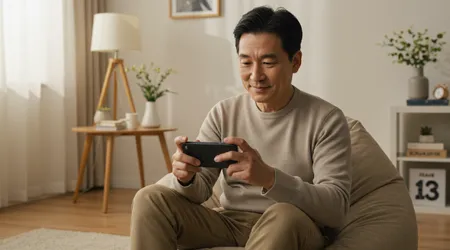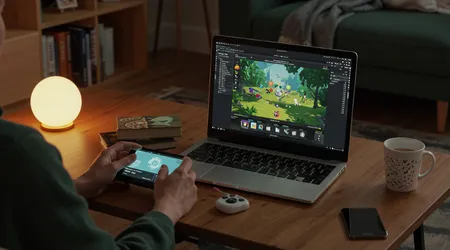The Rise of Cozy Games and Gamified Wellness: Redefining Gaming as Self-Care

The Rise of Cozy Games and Gamified Wellness has transformed gaming into a sanctuary for relaxation and personal growth.
Anúncios
Once dominated by high-stakes shooters and competitive esports, the gaming landscape now embraces titles that prioritize calm, creativity, and emotional well-being.
Cozy games like Stardew Valley and Animal Crossing: New Horizons invite players to tend virtual farms or build serene islands, offering a digital escape from life’s chaos.
Meanwhile, gamified wellness apps integrate game mechanics into fitness and mindfulness, turning self-care into an engaging adventure.
This shift reflects a broader cultural move toward valuing mental health and balance, with gaming at its heart.
Why are players flocking to these soothing experiences, and how are they reshaping our understanding of gaming’s role in daily life?
In 2025, the gaming industry thrives on diversity, with cozy games and wellness apps carving out significant niches.
According to a 2023 YouTube report, cozy gaming content saw a surge in viewership, with channels like Cozy K’s gaining traction for blending gaming with lifestyle vlogs.
This trend highlights a growing desire for experiences that nurture rather than adrenaline-fueled competition. Gamers, from casual players to dedicated enthusiasts, seek spaces to unwind, connect, and grow.
This article explores how The Rise of Cozy Games and Gamified Wellness redefines gaming as a tool for self-care, weaving together creativity, community, and personal empowerment.
The Appeal of Cozy Games: A Digital Haven
Cozy games captivate with their low-stakes, immersive worlds. Titles like Palia and A Short Hike emphasize exploration, creativity, and gentle narratives over conflict.
Their pastel aesthetics and soothing soundtracks create a sense of calm, inviting players to linger. These games don’t demand quick reflexes; they reward patience and curiosity, appealing to those craving respite.
The genre’s rise ties to societal shifts. With global stress levels climbing, players seek games that mirror self-care practices.
++ Staying Motivated When You’re Burnt Out from Gaming
Animal Crossing players, for instance, spent hours decorating virtual homes, a meditative act akin to journaling. This mirrors a broader trend: gaming as a refuge from real-world pressures, offering control and comfort.
Beyond escapism, cozy games foster emotional connections. In Palia, players collaborate to build communities, sharing resources in a stress-free environment.
This sense of belonging resonates with millennials and Gen Z, who value authenticity and connection. Cozy games thus become digital campfires, warming players with shared, tranquil experiences.

Gamified Wellness: Turning Self-Care into Play
Gamified wellness apps like Duolingo and Zombies, Run! make self-care engaging by blending game mechanics with daily tasks.
Points, badges, and leaderboards transform language learning or exercise into rewarding quests. The Rise of Cozy Games and Gamified Wellness reflects a cultural shift toward playful productivity, making self-improvement feel less like a chore.
These apps leverage intrinsic motivation. For example, FitOn uses progress bars and challenges to encourage workouts, while Headspace gamifies meditation with streaks and rewards.
A 2022 study from the Journal of Medical Internet Research found gamified health apps increased user engagement by 40%. This proves their power to sustain healthy habits.
Also read: How to Make Friends in the Gaming Community Without Toxicity
Community plays a key role here too. Apps like Strava let users share fitness achievements, fostering camaraderie.
By turning solitary tasks into social experiences, gamified wellness builds accountability and joy, redefining self-care as a collective, game-like journey.
Mental Health Benefits: Gaming as Therapy
Cozy games and gamified wellness offer tangible mental health benefits. Their repetitive, low-pressure tasks like harvesting crops or tracking meditation streaks mimic mindfulness practices.
These activities reduce anxiety by focusing the mind on simple, achievable goals, creating a sense of accomplishment.
Take Stardew Valley: its farming cycles provide structure and purpose, helping players manage stress. Similarly, Habitica turns daily tasks into RPG quests, rewarding users for completing chores.
These mechanics tap into dopamine-driven feedback loops, boosting mood and motivation without overwhelming the player.
Read more: Gaming and Nutrition: What to Eat Before a Long Session
The cozy gaming community amplifies these benefits. On platforms like Discord, players share tips for managing anxiety through games like Cozy Grove.
This communal support normalizes gaming as a valid self-care tool, challenging outdated stigmas about gaming’s value.
SEO Strategies for Cozy Gaming Content
To amplify The Rise of Cozy Games and Gamified Wellness in blogs, SEO is crucial. Use long-tail keywords like “best cozy games for relaxation” to target niche audiences.
Tools like Ahrefs help identify low-competition phrases with high search volume, ensuring content reaches curious gamers.
Engaging content is key. Write conversational posts with personal anecdotes, like how Unpacking helped you destress after a move.
Use descriptive image alt texts, such as “cozy game screenshot of Stardew Valley farm,” to boost discoverability. These tactics align with Google’s 2025 focus on user intent.
Backlinks from gaming forums or Reddit threads enhance authority. Share guides on cozy game strategies or wellness app reviews in communities like r/CozyGamers. Consistent, authentic engagement drives traffic, making your blog a go-to resource for cozy gaming enthusiasts.
Building Community Through Cozy Gaming
The cozy gaming community thrives on connection. Platforms like YouTube and Discord host vibrant groups where players share cozy game recommendations and lifestyle tips.
Creators like Kat of A Casual Gamer emphasize coziness as a mindset, blending gaming with self-care routines.
Events like Wholesome Direct 2025 showcase upcoming cozy titles, fostering excitement and unity. Players discuss games like Kitori Academy on social media, creating buzz that drives discoverability.
These interactions turn gaming into a shared cultural experience, strengthening community bonds.
Bloggers can tap into this by hosting giveaways or creating Discord servers for cozy game fans. Sharing personal stories, like decorating a virtual cabin in Palia, invites readers to connect. This community-driven approach amplifies engagement and builds loyal audiences.
Challenges and Criticisms of Cozy Gaming
Despite its appeal, cozy gaming faces scrutiny. Critics argue it lacks depth, with repetitive tasks feeling shallow compared to narrative-driven AAA titles. Yet, this simplicity is intentional, prioritizing relaxation over complexity, which suits its audience’s needs.
Monetization poses another challenge. Many cozy games rely on in-app purchases, which can disrupt their serene vibe.
Gamified wellness apps, like Calm, sometimes push premium subscriptions, alienating budget-conscious users. Developers must balance profitability with authenticity to maintain trust.
Accessibility is also a concern. Not all cozy games offer inclusive features like customizable controls or subtitles, limiting their reach.
Addressing these gaps ensures The Rise of Cozy Games and Gamified Wellness benefits diverse players, making self-care universally accessible.
The Future of Cozy Games and Wellness

Looking ahead, The Rise of Cozy Games and Gamified Wellness will deepen as technology evolves. VR cozy games, like virtual forest retreats, promise immersive relaxation.
Developers are exploring AI-driven narratives that adapt to players’ emotional states, enhancing personalization.
Wellness apps will integrate with wearables, like smartwatches tracking meditation progress in real-time.
This fusion of tech and gaming will make self-care seamless, embedding cozy principles into daily routines. Imagine a game that adjusts its difficulty based on your stress levels innovation awaits.
Indie studios will lead this charge, prioritizing creativity over profit. Events like Wholesome Direct will continue spotlighting unique titles, ensuring cozy gaming remains a vibrant, evolving genre. The future is bright for gaming as self-care.
Practical Examples: Bringing Cozy Gaming to Life
Consider Sarah, a teacher who unwinds with Unpacking. Arranging virtual furniture helps her process a recent move, blending nostalgia with calm.
Her blog post about this experience, optimized with keywords like “cozy games for stress relief,” ranks high on Google, drawing readers.
Then there’s Alex, a student using Habitica to manage assignments. By turning tasks into quests, he stays motivated and shares his progress on Twitch, building a small but engaged audience.
These examples show how The Rise of Cozy Games and Gamified Wellness empowers real people.
Bloggers can replicate this by creating content like “5 Cozy Games to Soothe Your Soul” or tutorials on using Headspace for mindfulness. Pair these with vibrant visuals and community engagement to maximize impact and relatability.
Table: Top Cozy Games and Wellness Apps in 2025
| Name | Type | Key Feature | Platform |
|---|---|---|---|
| Stardew Valley | Cozy Game | Farming, community building | PC, Console, Mobile |
| Animal Crossing: NH | Cozy Game | Island customization, social play | Nintendo Switch |
| Palia | Cozy Game | Open-world collaboration | PC, Console |
| Duolingo | Wellness App | Language learning with badges | Mobile, Web |
| Headspace | Wellness App | Guided meditation with streaks | Mobile, Web |
Conclusion: Gaming as a Self-Care Revolution
The Rise of Cozy Games and Gamified Wellness marks a pivotal shift in gaming’s purpose. No longer just entertainment, games like Stardew Valley and apps like Duolingo empower players to prioritize mental health and personal growth.
They offer safe spaces to relax, connect, and thrive, challenging the notion that gaming is frivolous. As technology advances, from VR retreats to AI-driven wellness, this trend will only grow, embedding self-care into our digital lives.
This movement invites us to rethink gaming’s role. Isn’t it time we embraced games that nurture rather than exhaust?
By blending creativity, community, and wellness, cozy gaming redefines play as a path to balance.
Bloggers, developers, and players alike can champion this revolution, crafting content and experiences that inspire joy and resilience in 2025 and beyond.
Frequently Asked Questions
What are cozy games?
Cozy games are low-stress, relaxing titles like Stardew Valley, focusing on creativity, exploration, and wholesome narratives, often with soothing aesthetics.
How do gamified wellness apps work?
Apps like Headspace use game mechanics points, badges, streaks to make self-care tasks like meditation or fitness engaging and rewarding.
Why are cozy games popular in 2025?
They meet a growing need for stress relief, offering calm, community-driven experiences that align with self-care trends, appealing to diverse audiences.
Can cozy games improve mental health?
Yes, their repetitive, low-pressure tasks reduce anxiety, while community engagement fosters connection, making them effective self-care tools.
How can bloggers leverage this trend?
Use SEO with long-tail keywords, share personal stories, and engage with communities on Discord or Reddit to build a loyal audience.
